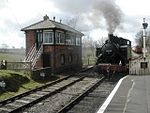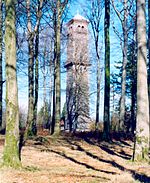Cranmore West railway station
Heritage railway stations in SomersetPages with no open date in Infobox stationRailway stations built for UK heritage railwaysSomerset building and structure stubsSouth West England railway station stubs ... and 1 more
Use British English from March 2018

Cranmore West is a railway station on the East Somerset Railway.
Excerpt from the Wikipedia article Cranmore West railway station (License: CC BY-SA 3.0, Authors, Images).Cranmore West railway station
Old Down Lane, Mendip Cranmore
Geographical coordinates (GPS) Address Nearby Places Show on map
Geographical coordinates (GPS)
| Latitude | Longitude |
|---|---|
| N 51.184 ° | E -2.483 ° |
Address
ESR Loco Shed and Workshop
Old Down Lane
BA4 4PX Mendip, Cranmore
England, United Kingdom
Open on Google Maps










